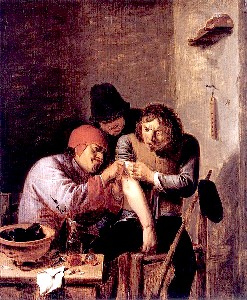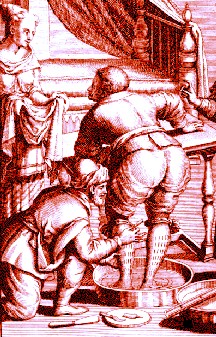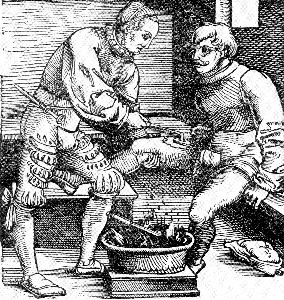
Gangrene Treatment Page Menu: 1 2 3 4 Next>>
Treating Gangrene During the Golden Age of Piracy, Page 3
Curing a Gangrene - Bleeding and Purging
"Yet in all these [types of wounds] there are some hopes of Cure." (Wiseman, p. 444)
For some of the mechanical cures of this problem,

Feeling by Adriaen Brouwer (1635)
we're going to turn to Wiseman, who has much to say on this aspect of the treatment.
"In the Care of Gangrenes, I shall begin my discourse of that which raiseth from Pain with Flux [flow] of humours and Inflammation. These most frequently attend great Contusions, Gun-shot Wounds, &c. and by suffocating the native Heat produce Mortification. In which cases a cooling and slender Diet ought to be observed: the Humours abounding in the body must be evacuated by Bleeding and Purging: Revulsion ought also to be made to avert the Humours from flowing to the diseased Parts…" (Wiseman, p. 444)
Purging is either done through the use of emetics to purge 'upwards' or glisters (enemas) to purge down.
Revulsion almost deserves a page unto itself. The simplest explanation is that it involved drawing the bad humors away from a damaged part via bloodletting. I have read of multiple ways of doing this, but the most common explanation is that you should bleed the patient at the point of anatomy farthest away from the physical insult. Thus, if gangrene were found in the left foot, you might let blood in the right arm. The idea is to pull the humors away from the damaged part. (For more on bloodletting, see this page.)
Curing a Gangrene - Scarification
Wiseman continues on the surgical treatments with scarification. Scarification is the process of bleeding a part by making a series of small incisions, either with a fleam or scalpel blade. Once the incisions are made, the part is left to bleed into a pan.

Scarification of a man's legs,
From
Prosperi
Alpini, De Medicinæ Ægyptiocum, p. 198
"And if there be a Wound or Abscess, and that Wound, &c. grow more painful, if the
Flesh also lose its ruddiness, and look pale and withered, and the Matter change to be thin and
gleety [slimy], you may suspect it corrupting: in which case it will be necessary that you scarifie to
the quick, and make it bleed freely.
By your Patient's sensible feeling, and by the first trickling down of the blood, you may judge of the Motificiation, But if the Gangrene have crept deeper, or arose from the bottom of the Wound, then scarifie accordingly unto the fleshy Parts: and if there be any Abscess lying under the Muscles or Lips of the Wound or Ulcer, let it out.
If in making such Scarification you chance to cut some Vessel, whereby a Flux of blood happeneth, have a care you choak not the Heat of the Part by crowding in Dossills [rolls of lint]; for soothe Mortification may be encreased. " (Wiseman, p. 444-5)
Sea-surgeon John Moyle gives us another vivid account of scarification along with a list of some medicines that should be applied to the scarified part if the bleeding procedure fails to work by itself.
"But now suppose a Tumor, Contusion or Wound happens to Gangreen.

Surgeon John Moyle
Then you are immediately to make deep Scarification, where the Gangreen seizeth; and to apply the strong
Lixivium [lye]... to fetch out the ill Blood.
But if you cannot stop it for all this; you must apply on your Scarifications, the Lixivium Capitalis, and Ol. Vitriol. [Oil of Vitriol or sulfuric acid] mixed and hot. You are to arm your Probe, and dip it in that Liquor, and touch the Scarifications with it, and put a little Lint or Tow thereon; and over that large Pledgits [wads of soft material] armed with Basilicon Major [an ointment which encourages pus formation]." (Moyle, p. 93-4)
Richard Wiseman suggests similar medicines be applied after scarification.
"...after Scarification, cleanse it of the clotted blood, by washing it with Brine, a strong Lixivium of Wood-ashes, or Tincture of Myrrh [an antiseptic that is still in use today], &c. and fill up the Scarification with Merc. præcipitat. troch. Polydæ, musæ [not sure on this one - it contains precipitate of Mercury though], or with Dossills [rolls of lint] dipt in ol. garyophyll. terebinth. [turpentine, applied for its cleansing properties] &c. actually hot. Unguent. Ægyptiac. [a detersive unguent formed of verdigris, vinegar, and honey] Is also hereto usefull... with the addition of sal Armoniac. [Powdered ammonium chloride] nitr. theriac. [a complex concoction containing opium] camph. [camphor] &c…. While these are applied to the gangrened Part, a good Defensative should be laid upon the Joynt or Parts above..." (Wiseman, p. 445)
Not all surgeons during this period thought scarification was a good idea. German surgeon Matthias Gottfried Purmann rails against its use. He explains, "Some Chirurgeons are for Scarifying the Gangrened part, or its Fore runners without distinction, but often proceed too rashly, when it may be prevented without so much Torture to the Patient..." He then goes on to recommend amputation if the part is beyond medicinal help.
Curing a Gangrene - Actual Cautery
The use of actual cauterization - that is burning the skin with red hot irons - varied depending on who was writing and how highly they prized the efficacy of the treatment over the intense pain that it caused the patient. Most of the period authors who talk of gangrene do not mention actual cautery as a treatment. Wiseman does.

Cauterization of the Leg from the 1532 printing of
Albucasis'
chirurgicorum omnium primarii
"Whereas on the contrary, an actual Cautery answers all Intentions: It not only consumeth the
Mortification, but drieth up the venomous Humour, thereby preventing its farther progress; and also
communicateth warmth to the languishing Parts, by virtue of which the Separation is much fathered,
and by working upon the gangrened Sloughs performed more easily, as you may see in my Practice
elsewhere." (Wiseman, p. 450)
John Atkins also suggests using cautery in this case, but only when nothing else has worked.
"Actual Cautery is the last Refuge; and is without all doubt the best Means can be used to resist Putrefaction [rotting]:
To make it answer our Hopes, we should apply it till its Effect reaches the quick [living, not gangrened] Parts, and all the nasty foul Sanies [serum, blood and/or pus, discharged by wounds] bred from the cadaverous Flesh, is in a manner dry'd up; then Nature immediately commences her Efforts for separating the Quick from the Dead; which, she would contend for, with less Success, if the Cauterizing were done by halves [only partially].
When we have used the [Cautery] Iron, we assist Nature's Endeavour's for a Seperation, by scarifying through the Depth of the Eschar [dead tissue], i. e. till it bleeds, and dressing those Incisions with Lenients [soothing medications] and Digestives [substance to promote healthy flesh formation in a wound]; use to the Whole Fomentations and Cataplasms [a poultice - soft moist mass, often heated and medicated, spread on cloth over the skin to treat inflamation], as before. If we fail of our End, after these Trials, I sea nothing remains but the Operation again." (Atkins, p. 154)
This ends the list of mechanical surgical techniques used to cure gangrenes. We'll look next at medicines and diet.

